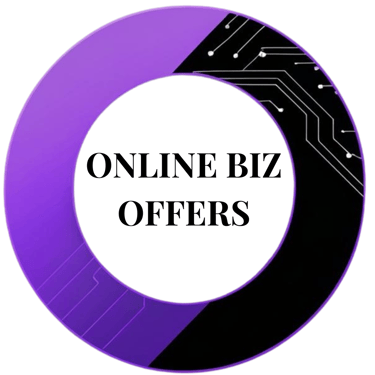Stop Scrolling, Start Creating ⚡ Visit Our Digital Store Now!
How to Scale Your Side Hustle Into a Full-Time Business (Without Burning Out)
Master how to scale your side hustle into a full-time business using proven strategies for growth, outsourcing, and automation. Get a practical 90-day action plan to build a sustainable online business.
MAKE MONEY ONLINEEMAIL MARKETINGSOCIAL MEDIADIGITAL MARKETINGE-COMMERCEAFFILIATE MARKETINGONLINE BUSINESS IDEASFREELANCING
Eddy Enoma
10/29/202519 min read
Turn Your Nights and Weekends into a Thriving, Automated Revenue Machine.
Introduction
Scaling a side hustle into a full-time business is one of the most rewarding entrepreneurial journeys you can take. But here's the truth: most people fail not because their idea is bad, but because they don't have a clear roadmap. They keep grinding alone, working nights and weekends, until burnout kills the dream before it even gets started. The good news? You don't have to figure this out alone. With the right strategy, systems, and tools, you can scale a side hustle into a thriving full-time operation faster than you think.
This guide breaks down exactly how to do it. Whether you're currently making $500 a month and want to hit $5,000, or you're already at $2,000 and ready to go full-time, you'll find actionable steps, realistic timelines, and the specific outsourcing and automation strategies that actually move the needle. The key is knowing what to prioritize, when to outsource, and which tools will save you the most time and money.
Let's get started.
Stage 1: The Side Hustle Phase (Your Foundation)
What You're Building: Revenue + Proof of Concept
When you're in side hustle mode, your job is simple: prove the business works. You're still working a day job (or another primary income source), which means you have limited time and probably zero budget for paid ads or fancy tools. This phase is about validation, not perfection.
Your realistic weekly time commitment is 10 to 15 hours. Yes, that's tight, but it's also why you need to be ruthlessly focused. You're not trying to be everywhere or have every feature. You're testing one core offer with one audience on one or two channels, getting real customers, and learning what resonates.
The main objectives here are straightforward. You want to hit $500 to $1,000 in monthly recurring or semi-recurring revenue. You want real customer feedback and testimonials. And you want to validate that there's actual demand, not just interest. Timeline-wise, expect 2 to 4 months if you're building on proven demand in your niche.
Your priority actions should focus on nailing your core offer first. Don't worry about having 50 products or seven different service packages. Pick one thing and make it great. You should also be building an email list from day one, even if it's small. Set up a simple landing page with a lead magnet (a free resource people actually want) and capture emails. This list is worth more than social media followers, and it's an asset you actually own. Get your first paying customers through direct outreach, content marketing, or your existing network. No ads required yet. Finally, create one consistent content asset per week, whether that's a blog post, YouTube video, or LinkedIn post. This builds authority and gives you something to point people toward.
Key metrics to track during this phase include weekly email subscribers added, monthly paying customers acquired, monthly revenue, and customer acquisition cost (even if it's just your time). These numbers will guide your next moves.
Stage 2: The Part-Time Business Phase (Building Momentum)
What You're Building: Systems + First Hires
You've hit about $1,500 to $3,000 monthly revenue, and now you need to push past the ceiling. This is where most solopreneurs get stuck because they're still doing everything themselves. The part-time phase is all about outsourcing the tasks that don't require your unique skills or voice, so you can focus on the work that drives revenue.
Your weekly time commitment at this stage should be 20 to 30 hours. You're still not full-time, but you're serious. You're also starting to invest in tools and potentially your first contractor.
Your objectives here are to hit $3,000 to $5,000 monthly revenue, reduce your personal workload by at least 40 percent, and build out your first documented systems. This phase typically lasts 2 to 4 months.
First, systemize your customer onboarding and delivery. Document exactly how you serve customers. Video walkthroughs, checklists, templates, everything. The goal is to make it so clear that you could hand it to someone else (because you will). Second, hire your first contractor for repetitive, non-core work. This could be a virtual assistant for scheduling and email, a content writer for your blog, or a customer support person. Your first hire should save you at least 5 to 8 hours per week. Third, launch a simple email automation sequence. If someone signs up for your list, they should get a welcome sequence, then regular value emails, then occasional offers. This runs 24/7 without you. Use EmailOctopus to set this up affordably. Fourth, expand to a second traffic or sales channel. If you were doing content marketing on LinkedIn, add YouTube or a blog. If you were doing direct outreach, add a paid small ad test. Diversification protects you and compounds your reach.
KPIs to track include monthly recurring revenue, churn rate (customers leaving), email list size and engagement rate, conversion rate from lead to paid customer, and contractor hours invested per week.
Stage 3: The Full-Time Business Phase (Going Solo and Scaling)
What You're Building: Scalable Systems + Team
You're now making $5,000+ monthly revenue and ready to jump. This is the phase where you can actually quit your day job with some runway. Your goal now is to reach $8,000 to $15,000+ monthly revenue within 3 to 6 months, hire your second and possibly third contractor, and build out your tech stack, so the business runs more on automation than your personal effort.
Your weekly time commitment drops to 20 to 25 hours because you've systematized everything. Yes, you work less but earn more. That's the whole point.
Your priority actions focus on scaling your highest-ROI channel. If you found that LinkedIn outreach generates customers at $50 per acquisition, double down there. If your blog posts rank and convert, produce more. Don't spread yourself thin across five channels. Second, set up paid traffic testing if you haven't already. Start small with $200 to $500 per month. Use platforms like Google Ads or simple lead generation tools. Track your cost per acquisition closely. Third, build or implement a sales system. Maybe it's a simple sales call booking flow with automation. Fourth, hire your operations person now. This could be a part-time VA handling admin, scheduling, customer communication, and basic analytics. This frees up your brain space.
Key metrics are monthly recurring revenue, customer lifetime value, cost per acquisition across channels, email list size and revenue per subscriber, and net profit margin (after tool and contractor costs).
Growth Strategy Playbook
Organic Acquisition Channels
Content marketing is the long-term play. Write one blog post or LinkedIn article every week focused on problems your customers have. Over 12 months, you'll have 52 pieces of content ranking in search engines and attracting inbound leads. Use SEOWriting AI to draft posts faster while maintaining quality. One post can generate leads for years.
Direct outreach works fast. Spend 30 minutes daily reaching out to ideal customers on LinkedIn or email. Keep it personal and focused on helping, not selling. This channel should generate 2 to 5 qualified conversations per week.
Email marketing to your existing list is your highest ROI channel. You own this relationship. Send one email per week with value. Ask for feedback. Share wins. Build trust. When you have an offer, they'll listen because you've been genuine.
Referrals from happy customers are free. Ask them to refer you. Make it easy with a simple referral incentive (discount, cash, or whatever fits your model). Happy customers are your best sales team.
Paid Acquisition (When You're Ready)
Google Ads or Facebook Ads work when your unit economics support them. Only test paid traffic once you know your cost per acquisition from organic channels and your customer lifetime value. If a customer is worth $2,000, and you can acquire them for $200, paid ads make sense. Start with $300 to $500 monthly budget.
LinkedIn ads work well for B2B services. Test a simple lead magnet ad. Your goal is to gather leads at $10 to $20 per lead, then nurture them into customers.
Conversion & Retention Tactics
Your landing page copy must be clear and benefit-focused. People don't care about your features; they care about their problems being solved.
Implement a simple pricing or package structure. Don't overcomplicate it. Usually three tiers work best: a starter tier that's accessible, a core tier that most people buy, and a premium tier for serious customers. Use Systeme.io to host your sales pages and payment processing.
Create an email nurture sequence. New leads get emails about your best content and a soft introduction to your offer. Use GetResponse to automate this. A simple four-email sequence can convert 10 to 15 percent of cold leads into customers or qualified prospects.
Upsells and cross-sells happen naturally once you have customers. If someone buys your entry-level product, what's the next step? Have a clear answer. A customer journey might look like: free lead magnet, core offer at $297, premium package at $1,500, and a high-ticket service at $5,000+.
Content & Partnerships
Publish long-form content weekly. Blog posts should be 1,500 to 2,500 words, optimized for search engines and reader value. Tools like Jenni AI help you write faster while maintaining quality.
Go for podcast guest appearances and interview opportunities. You'll reach new audiences and build authority. Podcasts are easier to land than you think if you have a specific angle or expertise.
Partner with complementary businesses or creators. If you sell email marketing courses, partner with someone selling sales funnel training. Cross-promote to each other's audiences. This costs nothing and expands your reach significantly.
Repurpose one piece of content into five. Write a blog post, then create a video, a LinkedIn article, an email sequence, and a Pinterest pin from the same core idea. Tools like Faceless.video help you create videos quickly without on-camera filming.
Quick-Win Experiments (Low Cost, High Learning)
Test a different landing page headline. Small text changes can lift conversion rates by 10 to 30 percent. Try changing "Learn the 5 Steps" to "Get Paid $5,000 Per Month" (assuming your offer allows). Use Gamma to create landing page variations quickly.
Run a micro-challenge or free webinar. Invite your email list to a three-day challenge or one-hour webinar where you teach something valuable. Offer your paid solution at the end. This is low-cost, builds authority, and generates urgent sales. Many businesses do this and see 20 to 40 percent conversion rates.
Outsourcing Playbook: Who to Hire and When
Tier 1: Your First Hire (Weeks 8-12 of Full Scaling)
Role: Virtual Assistant (Customer Support & Admin)
Core responsibilities include responding to customer emails and support tickets, scheduling appointments and calls, managing your calendar, basic data entry and list management, and scheduling social posts or emails.
Where to find them: Upwork, Fiverr, or specialized VA agencies. Look for someone with customer service experience and comfort with customer support and email management tools.
Sample job posting: "Seeking detail-oriented Virtual Assistant to handle customer emails, scheduling, and admin tasks for growing online business. 10-15 hours/week. Must be responsive, organized, and comfortable learning new tools. $10-15/hour or fixed monthly fee."
Screening questions: "Tell me about your experience managing customer emails and support tickets. Walk me through how you'd respond to an angry customer. What tools are you most comfortable with?" Then do a trial project before committing.
Expected cost: $500-$1,500 per month (depending on location and experience) or $10-$15/hour.
Onboarding checklist: Create a detailed SOP document with email templates, customer service guidelines, scheduling rules, and a list of tools they'll use. Do a 2-hour onboarding call. Give them access to your CRM or email platform. Set weekly 15-minute check-in calls for the first month.
Tier 2: Your Second Hire (Months 3-4 of Full Scaling)
Role: Content Writer or Marketing Assistant
Core responsibilities include writing blog posts or social media content, researching SEO keywords and competitor content, creating email sequences and marketing copy, and editing and formatting content for publication.
Hiring channels: Upwork, Content marketing agencies, or specialized freelancer platforms.
Sample posting: "Looking for experienced content writer (1,500-2,000 word posts) optimized for SEO. Must research keywords, write engaging copy, and deliver 2-3 posts/week. $150-300 per post or $1,500/month retainer. Must understand blog optimization and search engine best practices."
Screening: Ask them to write a sample blog post for your niche. Check if they understand SEO, can write conversationally, and deliver on time.
Cost: $1,500-$3,000 per month or $150-$400 per piece.
Onboarding: Provide style guide, brand voice examples, keyword list, and content calendar. Assign your first piece as a learning assignment with feedback. Set up weekly editorial reviews.
Tier 3: Specialized Roles (When Revenue Justifies)
Paid Ads Manager: Manages Google, Facebook, or LinkedIn ad campaigns. Hire when you're ready to invest $1,000+ monthly in ads. Cost: $1,500-$3,500/month or 20-30% of ad spend.
Customer Success Manager: Proactively helps customers get results, reducing churn. Hire at $5,000+ monthly revenue. Cost: $1,500-$2,500/month.
Bookkeeper/Finance Person: Tracks expenses, invoicing, and tax prep. Hire at $8,000+ monthly revenue. Cost: $500-$1,500/month.
Automation Blueprint: Tools & Systems
Your Core Tech Stack
Your email marketing and CRM should handle leads, customer communication, and automation. EmailOctopus is affordable and powerful for email capture and automation. GetResponse handles email plus basic CRM. Set up a welcome sequence that fires automatically when someone joins your list.
Payment processing and sales pages matter. Use ThriveCart for high-ticket offers or Systeme.io for all-in-one solutions (sales pages, email, payment, affiliate management).
Customer support can be handled by a simple tool that manages conversations efficiently. Set up templates and workflows, so your support person can respond quickly and consistently.
Project management and task tracking keep your team aligned. Use a simple visual tool to assign tasks, track progress, and see who's working on what.
Analytics and reporting mean nothing if you're not tracking it. Use Reclaim AI to block focus time on your calendar so you actually have time to review metrics weekly.
Key Automations to Build (In Order)
Automation 1: Lead to Welcome Email Trigger: Someone signs up for your list via landing page or lead magnet Action: Send welcome email immediately, then three follow-up emails over 5 days (email 1: thank you + introduce yourself; email 2: share your best content; email 3: share social proof/testimonials; email 4: soft pitch to your offer) Expected outcome: 15 to 25 percent of new subscribers become customers within 2 weeks Setup: Use GetResponse or EmailOctopus automation builder. Create the four-email sequence once, then it runs 24/7.
Automation 2: Customer Onboarding Sequence Trigger: New customer makes a purchase Action: Send order confirmation, password/login details, welcome video, first checklist, and a calendar link to schedule a kick-off call expected outcome: Faster customer success, fewer support questions, higher satisfaction Setup: This can be done in your email platform or Systeme.io that handles automation from purchase to delivery.
Automation 3: Re-engagement Campaign Trigger: Email subscriber hasn't opened an email in 60 days Action: Send a "We miss you" email with a special offer or your best content. If they don't engage in 30 more days, remove them from your list. Expected outcome: Keep your list healthy, recover some dormant subscribers, reduce unsubscribe complaints Setup: Most email platforms have automated re-engagement workflows built in.
Automation 4: Abandoned Lead Follow-Up Trigger: Someone visited your sales page but didn't buy, or booked a call but didn't show Action: Automatically send follow-up emails at 1 hour, 24 hours, and 72 hours after expected outcome: Recover 5 to 15 percent of lost sales through persistence Setup: Integration via your CRM or email platform's native automation.
Data & Reporting Plan
Track these metrics weekly: new email subscribers, email open and click rates, customer acquisition cost by channel, conversion rate from lead to customer, monthly recurring revenue, churn rate, and net profit. Create a simple dashboard using Google Sheets or your CRM's built-in analytics. Review metrics every Friday morning for 30 minutes. This tells you what's working and what needs adjustment.
90-Day Action Plan
Week 1 (Top 3 Priority Tasks)
Task 1: Define your core offer and target customer. Write one clear sentence describing who you serve and what problem you solve.
Owner: You. Estimated hours: 4. Success metric: Clear, specific offer statement that resonates with one real customer.
Task 2: Build a simple landing page with a lead magnet. Use Gamma to design it. Offer something free that attracts your ideal customer (template, checklist, mini-course, guide, etc.).
Owner: You. Estimated hours: 6. Success metric: Live landing page with email capture and 10+ signups within the week.
Task 3: Start one content channel. Choose one: blog, LinkedIn, YouTube, or podcast. Commit to publishing one piece per week.
Owner: You. Estimated hours: 5. Success metric: First piece published and shared with your network.
Week 2-3
Run outreach. Spend 30 minutes daily reaching out to ideal customers, offering free help or a consultation. Track conversations.
Owner: You. Estimated hours: 8. Success metric: 5 to 10 meaningful conversations with potential customers.
Create your first sales page for your core offer. Use Systeme.io or ThriveCart.
Owner: You or freelancer. Estimated hours: 8. Success metric: Live sales page with payment processing connected.
Set up email automation. Create your welcome sequence in GetResponse or EmailOctopus.
Owner: You. Estimated hours: 4. Success metric: Five-email sequence live and tested.
Week 4-6
Make your first sales. Use outreach, free consultations, or your landing page. Get three to five paying customers. Document exactly how you serve them using Loom to create video walkthroughs, then create checklists and templates.
Owner: You. Estimated hours: 15. Success metric: $500 to $1,500 in revenue and documented delivery process.
Launch paid traffic test (optional but recommended). Start with $200-$300 on Google Ads or LinkedIn Ads. Track cost per lead closely.
Owner: You or ads contractor. Estimated hours: 5. Success metric: Cost per acquisition data to inform future paid spending.
Week 7-9
Publish three pieces of content. Blog posts, LinkedIn articles, or videos optimized for SEO. Use SEOWriting AI to speed up drafting.
Owner: You or content contractor. Estimated hours: 12. Success metric: Content published and starting to get engagement.
Analyze early data. Look at which channel brought your best customers. Which content pieces got the most engagement? Which emails got opened most? Double down on winners.
Owner: You. Estimated hours: 3. Success metric: Clear understanding of your best performing channel and customer acquisition path.
Hire your first contractor. Bring on a VA for 8 to 10 hours per week to handle support, scheduling, and admin.
Owner: You. Estimated hours: 8 (interview, hiring, onboarding). Success metric: First contractor in place, handling at least 5 hours of your weekly tasks.
Week 10-12
Expand your email sequences. Add a monthly value newsletter, an upsell sequence (for people who bought your core offer), and a reactivation sequence for inactive leads. Use GetResponse to manage these flows.
Owner: You or contractor. Estimated hours: 6. Success metric: Automated email sequences running and generating measurable results.
Launch a second traffic or sales channel. If you were only doing content marketing, add direct outreach. If outreach only, add a webinar or content strategy. If ads only, add content. Diversify.
Owner: You or contractor. Estimated hours: 8. Success metric: Second channel live with documented results tracking.
Review and celebrate. You've likely hit $1,500 to $2,500 in monthly revenue by now. Review what worked, what didn't, and plan the next 90 days.
Owner: You. Estimated hours: 2. Success metric: Clear plan for month four and beyond.
Templates & SOPs
Template 1: Cold Outreach Email
Subject: Quick idea for [Their Company Name]
Hey [Name],
I was checking out [something specific about their work/company] and thought you might appreciate [relevant resource or insight].
[One paragraph offering genuine help or value, no pitch]
If it's useful, let me know. Happy to grab a quick call if you want to chat about [their pain point].
All the best, [Your name]
[Your website link]
Template 2: Job Posting for VA Contractor
"Virtual Assistant Needed: Customer Support & Admin (10-15 hrs/week)
We're looking for a reliable, responsive VA to handle:
Customer email responses and support tickets
Calendar and appointment scheduling
Basic data entry and CRM management
Task coordination with team
Ideal candidate:
2+ years customer service or VA experience
Comfort with Gmail, Calendly, and CRM tools
Fast response times and attention to detail
Available for US business hours
Compensation: $12-$15/hour or $1,200/month for fixed hours. Apply with a brief intro explaining your experience and why you're interested."
Template 3: Customer Onboarding Checklist
Welcome, [Customer Name]!
Your Account Setup:
You should receive a login email shortly at [email]. Set your password here: [link]
Watch this 5-minute walkthrough: [video link]
Add your first [item] to get started: [how-to link]
Your First Week:
Day 1: Complete account setup and intro video
Day 2-3: Complete the Getting Started checklist: [link]
Day 4: Join our customer community/group: [link]
Day 5: Schedule your one-on-one call with me: [booking link]
Questions? Email [support email] and we'll get back to you within 24 hours.
You've got this.
[Your name]
SOP: Daily Email Management
Purpose: Ensure all customer and prospect emails are answered within 24 hours.
Responsible Role: VA or Customer Support Person
Steps:
Every morning at 9 AM, check the support email inbox for new messages.
Categorize emails into: urgent (customer issue), sales inquiry, or general question.
Respond to urgent issues within 2 hours using the email templates provided.
Forward sales inquiries to [owner name] with a note of urgency.
Use template responses for common questions to save time.
Log all interactions in the CRM with resolution notes.
By 5 PM, ensure inbox is cleared, and all emails have a response or action assigned.
Send daily summary email to owner with # of emails received, any urgent issues, and new leads.
Risk Assessment & Contingencies
Risk 1: You Burn Out Before Scaling
Early warning signs: Working more than 20 hours/week without revenue growth, skipping weeks of content, or dreading your business work.
Mitigation: Set a hard stop on your weekly hours. If you hit 20 hours without hitting revenue targets, you're doing something inefficient. Hire earlier than you think you need to. Outsourcing is not optional at this stage.
Risk 2: Paid Ads Don't Work and You Waste Budget
Early warning signs: Cost per lead is 10x higher than expected, or ads run for two weeks with zero leads.
Mitigation: Test small before committing. Never spend more than $300-$500 on initial ad tests. Set a clear daily budget limit so you don't hemorrhage money. Track metrics daily and pause underperforming ads immediately. If paid ads don't work, double down on organic channels instead.
Risk 3: You Hire the Wrong Person and Waste Time
Early warning signs: Contractor misses deadlines, communication is poor, or work quality is low.
Mitigation: Do a paid trial project before committing to a contract. Ask for references. Start with part-time hours, not full commitment. Have clear SOPs, so expectations are explicit. Check in weekly during the first month.
Risk 4: Your Customer Acquisition Cost Climbs as You Grow
Early warning signs: Month 1 you acquire customers for $50 each, but by month 4 it's $150 each.
Mitigation: Track CAC obsessively every week. When it starts trending up, immediately test a new channel or refine your messaging. Sometimes the issue is not the channel but your offer or positioning. Refresh your pitch regularly.
Risk 5: You Build a Business That Requires Your Constant Presence
Early warning signs: If you take a week off, revenue drops to zero. All customers ask for you directly.
Mitigation: Document and delegate from day one. Build your systems around processes, not your personality. Create templates, checklists, and training materials so others can replicate your work. Your goal is a business that can operate without you present daily, even if you're still the owner.
Why Most Entrepreneurs Fail at Scaling (And How You Won't)
The data is clear: roughly 90% of side hustles never generate significant income. But it's not because the ideas are bad. It's because founders try to do everything themselves and burn out by month three. They're writing content, managing customers, handling invoices, chasing leads, and designing landing pages all at the same time.
The businesses that succeed follow a different pattern. They get obsessed with one thing. They automate ruthlessly. They hire early (even when it feels premature). They track metrics obsessively. And they reinvest profits back into tools and people, not lifestyle.
This guide gives you that exact pattern. Follow it, and you'll join the 10% that actually scale.
The Tools That Actually Matter (And The Ones You Can Skip)
Not all tools are created equal. Some save you days per month. Others are just noise. Here's what matters at each stage:
Stage 1 (Side Hustle): You need EmailOctopus for email capture, Gamma for landing pages, and Systeme.io for payment processing. That's it. Everything else is optional.
Stage 2 (Part-Time): Add a simple customer support tool, basic task management, and SEOWriting AI or Jenni AI for faster content creation.
Stage 3 (Full-Time): Layer in Reclaim AI for calendar management, GetResponse for advanced email automation, and Loom for process documentation with your team.
Everything else is nice to have, not need to have. Start lean, add tools only when you have clear ROI.
How to Build a Business That Doesn't Require You
The biggest mistake founders make is building a business dependent entirely on their personal effort. You become the bottleneck. You can't scale past 8 to 10 hours per week without burning out because every customer interaction requires your time.
The solution? Build systems, not just services. Document every process. Create templates. Record videos using Loom for your team training. Build email sequences that run 24/7. Hire people to handle repetitive tasks. Use Faceless.video to create content without your constant involvement.
By the time you hit Stage 3 (full-time), your business should be able to run for a week without you present. Not because you've abandoned it, but because the systems are that solid. That's what real scaling looks like.
One Last Thing: The Mindset Shift You Need
Scaling a side hustle requires a mindset shift that most people struggle with. You have to go from being a doer to being a builder. From trading time for money to creating assets that generate income without your constant input. From thinking small to thinking big.
This is hard. Most people never make this shift. They stay stuck in the execution phase, convinced that doing more of what they're already doing will eventually work. It won't.
Your job at Stage 1 is to prove the business works. Stage 2 is to prove it can be delegated. Stage 3 is to prove it can scale. If you understand these stages and follow them in order, you'll be in the 10% that actually makes it.
The difference between you and someone else who fails isn't intelligence or luck. It's whether you take action today and follow through for 90 days. Everything after that compounds.
Start Today: Your 3-Item To-Do List
Define your core offer in one sentence. Who do you serve? What problem do you solve? Write it down now. Use this clarity to build everything else. (30 minutes)
Choose your first content channel and commit. LinkedIn, blog, YouTube, or podcast. Pick one. Commit to publishing one piece per week for the next 12 weeks. Use SEOWriting AI to speed up the writing process. (15 minutes to decide, 2–3 hours to create first piece)
Create a simple landing page with a lead magnet. Use Gamma to design it in minutes. Capture emails with EmailOctopus. Get your first 10 signups this week. (2-3 hours)
These three things, done this week, will set you on the path to scaling your side hustle into full-time income. You don't need a perfect plan or all the tools figured out. You need momentum, clarity, and consistency.
Start now. Your full-time business is waiting on the other side of action.
Ready to move from reading to doing? Don't lose the momentum from this article. Join the free newsletter for exclusive strategies and your next action plan delivered straight to your inbox. 👇
Subscribe for Exclusive Tips & Updates. Enter Your Email Below!



Get the latest strategies to create, automate, and monetize with AI, content, and digital marketing straight to your inbox!
🔒 We respect your privacy. Your email is safe with us. Unsubscribe anytime.
Address
Sporerweg 16
94234 Viechtach, Germany
Contacts Us
(049) 170 499 6273
Subscribe to our newsletter
© 2025 Onlinebizoffers. All rights reserved.










